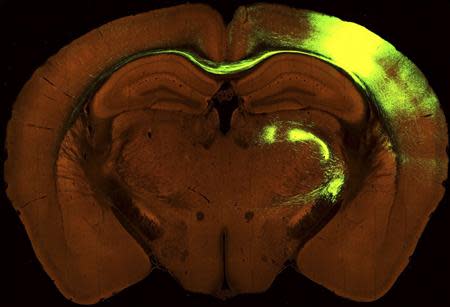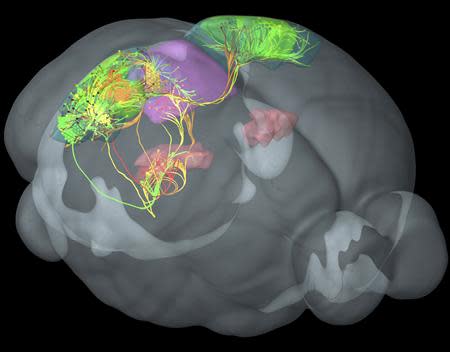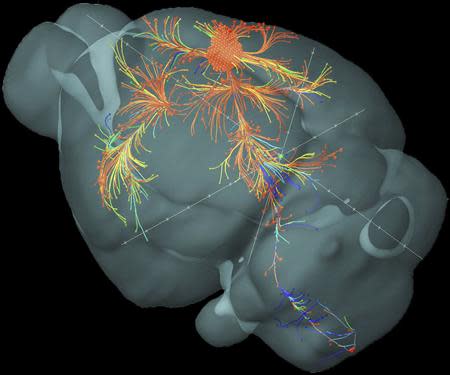Scientists unveil first wiring diagram of mouse's brain
By Sharon Begley WASHINGTON (Reuters) - A year to the day after U.S. President Barack Obama announced a $100 million "BRAIN Initiative" to accelerate discoveries in how gray matter thinks, feels, remembers, and sometimes succumbs to devastating diseases, scientists on Wednesday said they had achieved a key milestone toward that goal. Writing in the journal Nature, they unveiled the mouse 'connectome,' a map showing the sinuous connections that neurons make throughout the mouse brain as they form functional circuits. The mouse connectome "provides the most detailed analysis of brain circuitry currently available for any mammalian brain," said neuroscientist David Van Essen of Washington University in St. Louis, co-leader of the human connectome project, which aims to do that for Homo sapiens. "It is truly a landmark study." A connectome is essentially a wiring diagram. It shows how each of the millions or billions of neurons (gray matter) in a brain each connect to thousands of other neurons through projections called axons, the white matter, and thereby allow brain regions to communicate to produce behavior, intelligence, and personality. Such a diagram could reveal, say, how neurons that register the taste of a cookie fan out to circuits that store memories and unleash a torrent of remembrances of things past. And it could reveal what causes those circuits to malfunction in diseases such as Alzheimer's. Before the mouse, the only species for which scientists had created an essentially complete connectome was the roundworm C. elegans. It has 302 neurons. The human brain has some 86 billion, each making as many as 10,000 connections. GLOWING NEURONS For the mouse connectome, scientists led by Hongkui Zeng of the Allen Institute for Brain Science in Seattle, Washington, used some of the 21st-century techniques that are required to create a human connectome. For the mouse, the key was to make neuronal connections literally shine. To do that, Zeng's team injected viruses into precise spots in the brains of living mice. The viruses produce a special protein that fluoresces green. When the glowing protein diffuses throughout the neurons and their axons, the circuits show up under a microscope after the mouse is killed and its brain sliced. Out of 295 distinct structures in the mouse brain, the technique revealed the neuronal highways into and out of all but 18. Many of the missing ones are tiny structures close to the bottom of the brain which are hard to hit with the virus. The map revealed several surprises about brain wiring. Connections that stay on one side of the brain "seem to be always stronger" than those that cross hemispheres, Zeng said. The mouse's neuronal connections also vary widely in strength. That "must be contributing to brain network computation," she said. "We think a small number of strong connections and a large number of weak connections may be a fundamental network organization property to allow greater capacity of information processing." The mouse connectome unveiled on Wednesday is a medium-scale map, showing long-range and local connections. It does not have the resolution to reveal the precise neuron-to-neuron connections, or synapses, as a "microscale" connectome would, though that is a goal. A large-scale map is the goal of the Human Connectome Project, which the National Institutes of Health announced in 2010 and which Van Essen calls "one of the great scientific challenges of the 21st century." It is being produced using special technique called diffusion tensor imaging in living brains. The human connectome will resemble the Human Genome Project in a key way. Just as the genome project discovered the precise sequence of three billion molecules common to the vast majority of humans' DNA, serving as a reference book against which to measure individual genetic differences, so the connectome will first reveal neuro-commonalities and, eventually, the uniqueness of each individual brain. (Reporting by Sharon Begley; Editing by Julie Steenhuysen and James Dalgleish)




